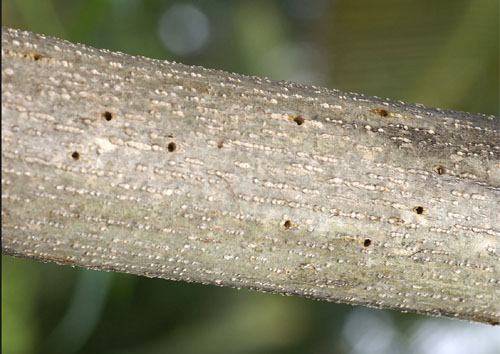|
Research studies |
| |
|
It is a small deciduous tree
attaining 2 to 6 m in height having oblong or ovate
leaves with a shining surface. The production of
this fruit has attracted several growers for its low
cultivation cost, drought tolerance and export
potential. |
 |
|
More... |
Farmers Help Desk |
| |
 |
|
Farmers can utilize the services by posting queries
through e-mails, telephones on scientific practices
and make pomegranate cultivation profitable.
Read More
|
|
|
|
|
|
|
|
|
|
Pest Management & Diagnosis!
|
Shot hole
borer Xyleborus sp. (Scolytidae: Coleoptera)
|
|

Symptoms :
This is becoming a major pest
nowadays on pomegranate in Karnataka. Early diagnosis
with symptoms is a must. Hence, regular visit to
orchards by growers is suggested. Signs of lateral
branch yellowing to quick drying of full tree, should be
immediately brought to notice of specialists and
treatments should be undertaken as follows:
-
Control:
-
·
Drench soil around main trunk with a mixture of
chlorpyriphos 2.5 ml with altering recommended
fungicides (carbendazim 1g/litre or propiconazole
2ml/litre) at monthly intervals.
-
If pest is
severe, repeat the above drenching after a
month.
-
If
infestation is low, drench with Azadirachtin
(0.15%) 3ml/litre around main trunk 2-3 litres
of mixture/tree with either of the above
fungicides.
-
Avoid
water logging and keep soil raked and aerated.
-
Infested
trees should be uprooted and burnt, especially
the root zone.
-
Pits of
uprooted trees should be treated with
chlorpyrifos 2.5 ml/litre, by thoroughly
drenching.
-
Drench soil
with chlorpyriphos 2.5ml/litre around all
un-infested tress prophylactically once in six
months, followed by a spray on trees with
Quinalphos 2.5ml/litre, followed by Azadirachtin
1500 ppm 3 ml/litre. Avoid leaving infested
trees in field after uprooting.
In case of nematode occurrence, need based
application of either phorate 25g/ plant or
carbofuran 40g/plant to the basins have to be
supplemented to bring down nematode population.
|
|
 |
|
|
|
|
|
|
|